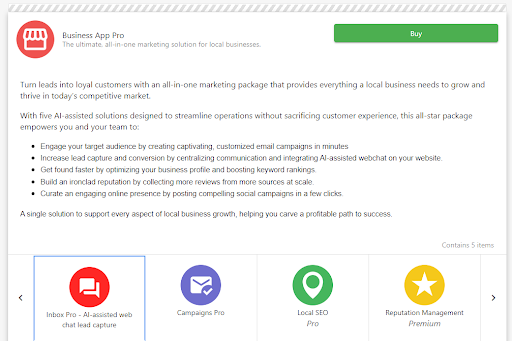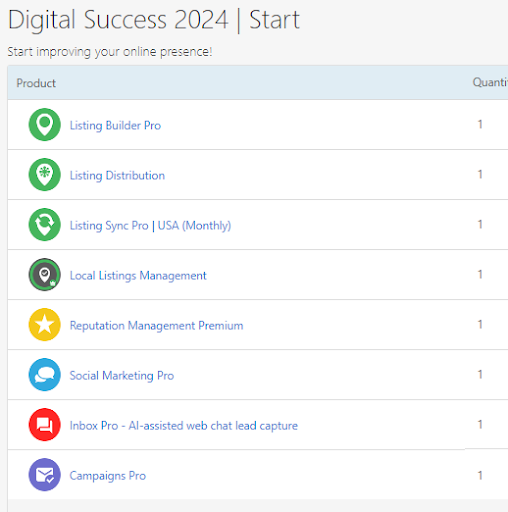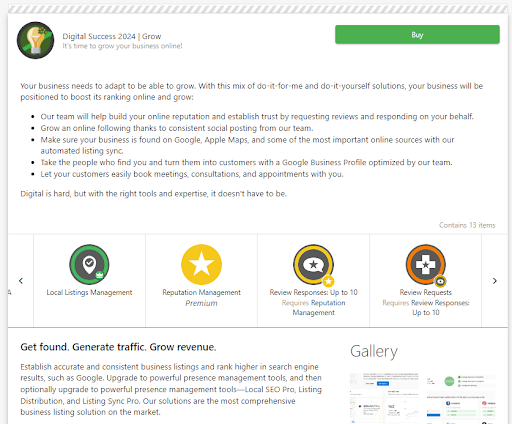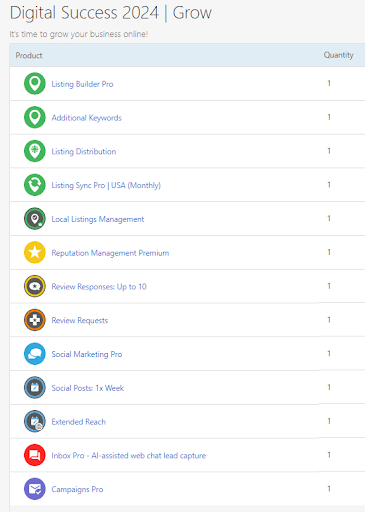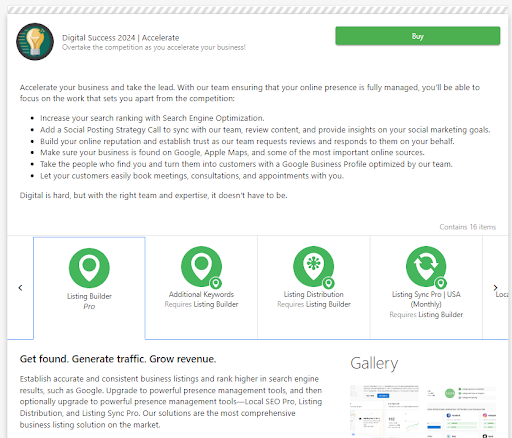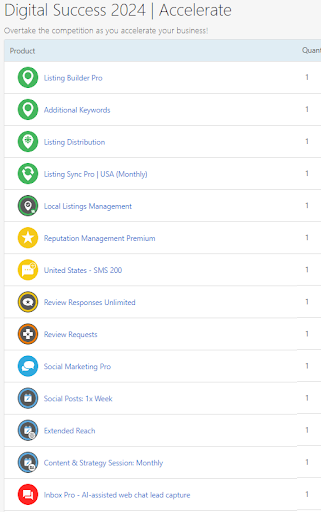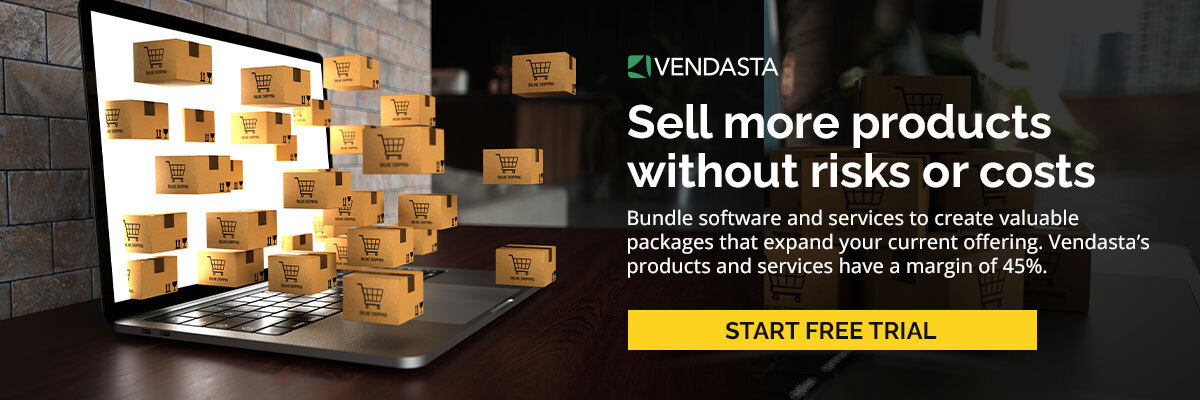Strategies for optimizing pricing on digital marketing packages
Selling digital marketing packages demands not just expertise but a strategic pricing approach. In this comprehensive guide, we will talk about how to optimize digital marketing pricing packages so you can sell more.
Learn all about bundling and get the guide: How to scale revenue by selling high-margin product and service bundles.
Pricing is as much an art as it is a science. Our discussion will go beyond the basics, helping your digital agency startup get a better handle on costs and ways of maintaining competitiveness to better navigate pricing trends in 2024. Your journey to thriving in this competitive market begins here, so buckle up and hold on tight.
How much do digital marketing packages cost in 2024?
In 2024, digital marketing pricing will be just as diverse as the strategies it encompasses. So, let's get into the nitty-gritty and discuss the factors that influence the cost of digital marketing pricing packages.
The average cost of a digital marketing package
The average cost of digital marketing packages in 2024 is akin to the tide—ever-changing. Depending on how many services are included and how much skill you bring to the table, these packages can range from a one-time payment of $75 up to $10,000 per month.
When determining pricing, consider the scope of services you want to offer. If you plan to partner with a white-label digital agency, that often means you’ll have a harder sell and need to deliver even greater value in return. However, bear in mind that opting for a more comprehensive package might translate to higher revenue.
Tailoring services to client needs
Think of digital marketing pricing packages as a customizable menu and you have complete ownership of choosing every dish. However, it is important to remember that customers don’t actually care about what it is that you are selling—they care about filling a need or solving a problem.
The cost difference isn't just about the services—it's also about how much expertise is needed. Basic stuff is good for smaller budgets, but if your client wants advanced strategies, it takes more time and effort. Knowing what both you and your client need helps you customize services and prices to fit your business goals.
Also see: How to Grow a Digital Agency: Boost Your Revenue by 237%
Different pricing models
The pricing models for digital marketing packages come in an assortment of different flavors. Each one has its perks (and drawbacks), so let’s take a look at the most popular ones:
Hourly rates
If your client needs a quick task or consultation, like setting up a social media account or brief troubleshooting, an hourly rate model is ideal. It gives them flexibility, paying only for the time spent, but it may not be the most cost-effective for ongoing, extensive projects.
Monthly retainers
Think of this like subscribing to continuous support. If your client’s business requires ongoing assistance, such as regular content creation or social media management, a monthly retainer provides a predictable monthly budget.
Project-based pricing
This model is suitable for specific campaigns or initiatives with well-defined scopes. If they're launching a new product or running a targeted marketing campaign, project-based pricing offers clarity on costs right from the start, ensuring they know what to expect for the entire project.
Project-based pricing can come with complications if things go out of scope, so make sure if you make amendments that you get everything in writing.
Factors that go into pricing digital marketing packages
Let's break down the factors that influence these costs to help provide you with a better understanding of what goes into crafting an appealing price tag.
1. Scope of work
Consider what’s included in the service package. Does it cover basic services like social media management and content creation, or does it extend to more advanced strategies such as search engine optimization (SEO) and paid advertising? The breadth of services directly impacts the overall cost, so it's key to align the scope with your client’s needs.
2. Target audience and industry competitiveness
The nature of your target audience and the competitiveness of the industry play a big role in how you price your service packages.
It’s a lot like trying to decide which all-natural peanut butter to choose from the grocery store. It’s just ground peanuts, so what warrants paying $5 when a similar jar is only $3? All this is to say that if you’re the $5 jar in this scenario, you’re going to be in big trouble unless you lower your price.
Additionally, if you're focusing on a specific group of clients who need personalized plans, it might cost more. Similarly, if they're in a really competitive industry that requires detailed and resource-heavy campaigns, it can affect how much to charge too.
3. Desired outcomes
Is your ideal client aiming for brand awareness, lead generation, or increased sales? What about all three?
More complexity means using more resources and, in return, costing more money. Agencies should also adjust their approach and allocate resources differently based on their clients’ specific objectives.
4. Value and return on investment (ROI)
Beyond the monetary aspect, it's important to consider the value you are bringing to the table. A higher-priced package from an expert digital marketer may offer more high-quality services, leading to better results for your client and a higher ROI. It’s important to help your clients understand that they are not spending money but making a strategic investment in the growth of their brand by doing business with you.
Also see: Digital agency goes from start-up to $250,000 in annual revenue
Types of digital marketing packages
When it comes to digital marketing, choosing the right digital marketing package is like trying to find a needle in a haystack. Businesses are spoiled for choice, so what are you going to do to ensure they choose yours? Make it so appealing that they’re compelled to click.
How, you might ask? By designing digital marketing pricing packages that help them achieve a specific goal, such as lead generation, brand awareness, and E-commerce.
Let us show you what we mean:
Lead generation packages
What they do:
- These packages are all about finding and turning curious visitors into loyal customers.
- They offer smart strategies to attract the right kind of attention and convince visitors to take action.
What's inside:
- Clever campaign tools and templates to make visitors say, "Hey, I want to know more!"
- CRM tools to understand what leads like and dislike.
- Special competitive reports and insights to track how many leads decide to stick around.
Here is an example of what this might look like:
Brand awareness packages
What they do:
- These packages act as a spotlight that makes a business stand out online.
- They use social media, content marketing, and other reputation management strategies to get people excited and talking about the business.
What's Inside:
- Comprehensive social media, reputation management, and content marketing strategies.
- Tools and reports to track how many people view and engage with the content.
- Sentiment analysis tracking is used to measure how the general public feels about the business.
E-commerce sales packages
What they do:
- These packages are like the ultimate salesperson, convincing people to purchase your clients' products and services directly from their website.
- They use special online tactics to showcase products and make customers hit the "Buy Now" button.
What's Inside:
- SEO (Search Engine Optimization) products and services to make products easy to find.
- Smart ads and email campaign services.
- E-commerce website design, copy drafting, and hosting services.
This type of package could look a lot like this: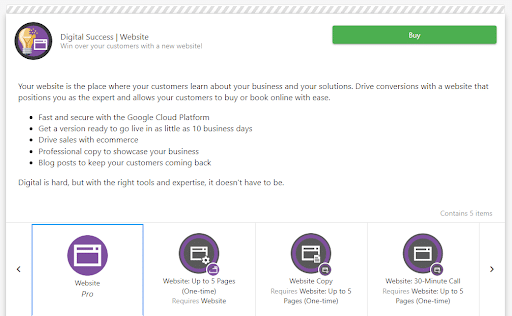
Understanding the difference between basic, intermediate, and advanced packages
You have probably noticed that your current clients are in different stages of growth. Some may be well-established, while others are in their infancy. Each business will have needs and problems they are looking to solve with varying levels of complexity. That’s where different package levels can come in handy.
Basic packages
What they are:
- Perfect for small to medium-sized local businesses taking their first steps into digital marketing.
- Acts like a starter pack with essential tools, reporting features, and more for effectively operating online.
- Ideal for those who have a modest budget and are fine with “DIY” solutions.
What's Inside:
- Basic tools for social media, listings, reputation management, a bit of SEO, and simple content creation.
- Basic website hosting, copywriting, and management services.
- Campaign management services, website chat boxes, and more.
Your basic beginner package could look a lot like this: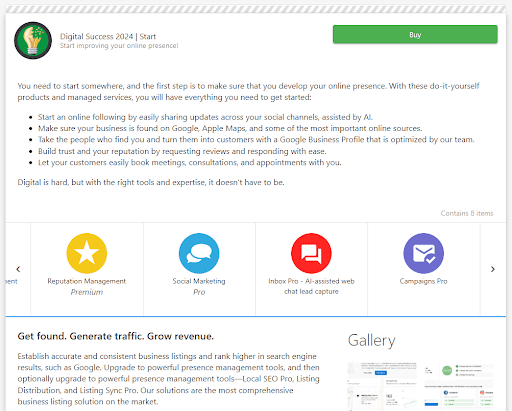
And feature products like this:
Intermediate packages
What they are:
- For mid-sized businesses ready to scale and level up their digital presence.
- More advanced tools and strategies designed to reach a larger audience.
- Perfect for businesses that want to grow but don’t have the time to completely manage their digital marketing.
What's inside:
- Advanced SEO tools and strategies, email campaigns, and PPC (Pay-Per-Click) campaigns.
- Listing tools, advanced reputation management features, and recurring social media content fulfillment services.
Your intermediate package may look similar to this:
And feature products like this:
Advanced Packages
What they are:
- Comprehensive advanced services that are designed to help businesses scale quickly.
- Full-service fulfillment and automation that takes the pressure off of businesses that need to focus on their goals.
What's inside:
- Everything from advanced analytics and reporting, to lead generation software.
- Expert fulfillment services for social media, long-form content, website SEO, and more.
- Automation and AI tech, such as website chatbots, and PPC digital advertising.
Your advanced package may look similar to this:
And feature products like this:
Choosing the right package
Helping your clients pick the right package is like choosing the perfect tool for a job. Each package is designed to help businesses achieve their unique goals. Whether it's a basic, intermediate, or advanced package, the key is to match the tools inside with the goals of today so your clients can focus on the goals of tomorrow.
Pro tip: Having a hard time creating the perfect digital marketing pricing packages? Check out Vendasta’s recommended packages for pre-built templates with complete product ranges, FAQs, photo galleries, and assets to help you sell even faster.
How to price your packages for digital marketing clients
Determining the right pricing strategy for your digital marketing packages is an important step in ensuring that you stay profitable and satisfy your clients. Here are some practical tips and strategies that you can use right away:
Tip 1: Conduct thorough market research
Before setting your prices, look under the surface to better understand industry standards and competitor pricing. Analyze the range of services offered by your direct competition and identify any gaps or unique selling propositions that your digital agency can leverage to your advantage.
Pro tip: When starting your research, utilize online tools, unbiased industry reports, and competitor websites to gather the most accurate market insights.
Tip 2: Analyze competitors' pricing
Take note of their service offerings, package structures, and how they position themselves. Also, identify any additional services, perks, or unique approaches they offer that make them stand out.
Pro tip: Identify areas where your agency can provide better value or differentiate itself to justify premium pricing. For example, look at public reviews to see what their 5-star versus their 1 or 2-star reviews are saying to get a clear, unbiased picture.
Tip 3: Understand target audience budgets
For many business owners, times are tough right now. That’s why you should tailor your pricing to match the budget constraints of your target client. Consider the size and financial capacity of the businesses you aim to serve. Offering flexible pricing options that cater to different budget levels can attract a broader range of clients and potentially help them stick around.
Pro tip: Create tiered packages to accommodate various budget ranges, providing clients with options based on their specific needs and financial capabilities.
Tip 4: Evaluate your agency's expertise and experience
You know how awesome you are, but do your clients? Your time is worth something, so don’t be afraid to factor in your agency's expertise, experience, and the unique value you bring to the table. Highlight any specialized skills, industry knowledge, or innovative approaches that set your agency apart.
The depth of your team's expertise should always be reflected in your pricing—people are likely to spend more if they know they will be getting better quality services.
Pro tip: Showcase case studies and success stories to demonstrate the tangible results your agency has achieved for clients.
Tip 5: Quantify the value delivered
Clearly communicate the value proposition of your services. Outline the direct benefits clients can expect and how your digital marketing strategies contribute to their business growth. Quantifying the potential return on investment (ROI) can justify higher price points.
Pro tip: Use metrics such as increased website traffic, lead generation, or revenue growth to showcase the tangible outcomes clients may receive.
Tip 6: Consider packaging and bundling
Experiment with different packaging and bundling strategies. Bundling popular services with complementary add-ons can create more perceived value for clients and streamline your service delivery. Offering packages with varying levels of service also caters to different client needs.
Pro tip: Bundle “sticky” services like website hosting with less popular but equally valuable services like SEO to get clients to purchase more of your offerings while receiving even better long-term results.
How to bundle digital marketing services
Bundling digital marketing services means putting different services together in one package to make it easier for clients to get what they need. For overwhelmed businesses with hundreds of options to choose from online, this approach helps save time and money, making it simpler for them to handle all their marketing needs at once.
Benefits of bundling
- Cost savings: Bundling allows clients to access a variety of services at a consolidated price, often resulting in cost savings compared to purchasing each service individually. This can be particularly appealing to clients operating on a budget.
- Streamlined processes: Coordinating various aspects of a campaign becomes more efficient when services are bundled, leading to smoother execution and better collaboration within the agency.
- Comprehensive solutions: Bundled packages provide clients with well-rounded solutions that cover multiple facets of digital marketing. This simplifies decision-making for clients and ensures a more holistic approach to their digital marketing strategy.
Examples of effective service bundles:
1. Startup booster packages: This type of bundle caters to startup businesses looking to establish a strong online presence.It may include services such as:
- Website development
- Social media setup
- Basic SEO optimization
- Initial content marketing strategy
2. E-commerce accelerator packages: Designed for online retailers, this type of bundle combines multiple services to boost sales and enhance the online shopping experience.It may include services such as:
- E-commerce website optimization
- Social media advertising
- Email marketing campaigns
- Product content creation
3. Brand revitalization packages: Out with the old and in with the new, we always say. This type of bundle is aimed at established brands seeking a refresh.This bundle could include services such as:
- Brand identity redesign
- Reputation management
- Advanced SEO strategies
- Targeted PR campaigns
Conclusion
As you navigate digital marketing in 2024, the key takeaway is to adapt your pricing strategies, stay responsive to market trends, and don’t be a stranger to evolving client needs. Digital marketing pricing packages ensure agencies deliver the best value, all while fostering enduring client relationships along the way.


